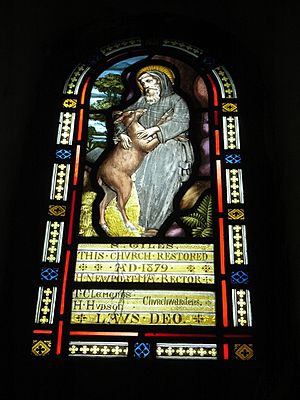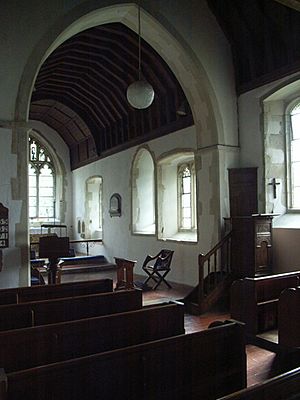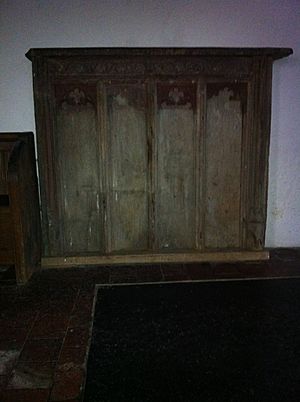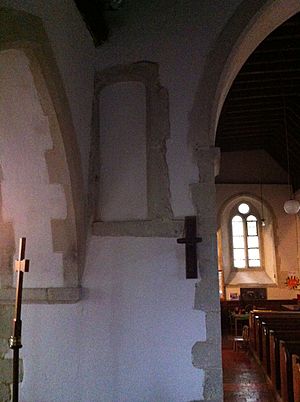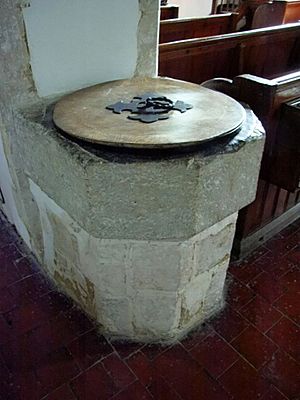St Giles Church, Wormshill facts for kids
Quick facts for kids St. Giles Church, Wormshill |
|
|---|---|

The south wall of the church
|
|
| Denomination | Church of England |
| History | |
| Dedication | Saint Giles |
| Architecture | |
| Heritage designation | Grade II |
| Designated | 26 April 1968 |
| Specifications | |
| Bells | 6 (full circle) |
| Tenor bell weight | 3 long cwt 1 qr 15 lb (379 lb or 172 kg) |
| Administration | |
| Deanery | Sittingbourne |
| Archdeaconry | Maidstone |
| Diocese | Canterbury |
| Province | Canterbury |
St Giles Church is the only church in the small village of Wormshill in Kent, England. It is an Anglican church, meaning it belongs to the Church of England. The church is named after Saint Giles. It is part of a group of churches that includes Tunstall, Bredgar, Milstead, Bicknor, Frinsted, and Rodmersham. St Giles Church is a special old building, listed as Grade II, which means it is important and protected.
Contents
History of St Giles Church
This church has been around for a very long time, even before the Normans came to England in 1066! Records from the Domesday Book in 1086 show that a church was already here. Its value hadn't changed much, suggesting no big building work had happened recently.
In the south wall of the main part of the church (the nave), near the porch, there's a window that might be from the Anglo-Saxon period. It was hidden for many years and found again in 1879. Experts think it could be from the early 11th century or even earlier.
The name Wormshill itself has old roots, possibly linked to the Anglo-Saxon god Wōden. The church shows signs of Norman building styles, meaning parts of it were built by the Normans after they arrived. Inside, there's a wooden chest from the 13th century that was found in the early 1900s. The church's official records, like marriage and birth details, go all the way back to 1700.
In 2007, the church and its grounds were used for filming an episode of the TV show EastEnders. The film crew even added fake gravestones and an old-fashioned street lamp to make it look right for the show!
Sadly, in September 2010, a heavy brass altar cross and two brass candlesticks were stolen from the church. They had been there for at least 150 years. A reward was offered to get them back.
Church Design and Features
Outside the Church
From the outside, St Giles Church is built mostly from flint stones, with special cut stones (dressings) around windows and doors. Over the years, different types of stone were used for repairs, like Caen stone, Reigate stone, chalk, Ragstone, and later Bath stone. The roof is made of tiles.
The oldest part of the church is the nave, built in the early 11th century. This is where the possible Anglo-Saxon window is, now filled with a stained glass picture of St Giles. In the 13th century, the church was made bigger by adding an aisle (a side section) to the north.
The south porch, which is the entrance, was built in the late 13th or 14th century. It's made of wood covered with weatherboards, sitting on a flint base. Inside the porch, there's a stone basin called a stoup from the 15th century. In old times, people would use it to hold holy water.
A tower was added at the west end of the church. The first part of the tower was built at the same time the nave was extended. Later, in the 15th century, the top part of the tower was added, where the bells are now. The top of the tower has a decorative, castle-like edge.
The church looks very similar today to how it did 200 years ago, as shown in an old painting from 1807. It has been repaired many times, especially the roof, and the tower and porch were rebuilt in 1903.
Inside the Church
The chancel, the part of the church where the altar is, was built in the 13th century. It's a bit narrower and lower than the nave. The large window at the east end of the church is from the 15th century and shows a beautiful scene of an angel crowning the Virgin Mary with Jesus watching.
The arch that separates the nave from the chancel was added during a restoration in the 19th century. There used to be a wooden screen, called a rood loft, above this arch. A staircase led up to it, but the doorway to this stair is now blocked up. A piece of the old wooden screen from the 14th century is still preserved against the north wall.
Next to the chancel, on the north side, is a chapel from the 13th century. It might have been a "lady chapel" in the past, dedicated to the Virgin Mary.
Major repairs happened in 1789, 1879, and again in 1901. The church is built in the Early English style, which is a type of Gothic architecture.
After the 1879 restoration, new stained glass windows were added. One in the possible Saxon opening shows Saint Giles holding a deer, which is part of his story. Another window shows the coat of arms of the Northwood family, who used to own land in the area.
The font (where baptisms take place) in the church is very old, from the Norman period, or possibly even Saxon times. The pulpit, where the priest gives sermons, is also very old. Some say it's from the Tudor period, others say Jacobean. It has six sides and carved decorations.
Music at St Giles
Organ
The church has an organ from the 18th century. It was brought here from a church in Brighton.
Bells
St Giles Church has a set of six bells. They are special because they are very light, and they have an interesting story about how they were restored.
In 1944, a 16-year-old named Michael Nightingale started a savings account to raise money for new bells. He wanted to replace the old ones with a full set of six. Fifty years later, his dream came true! One of the bells was original, and five others were found from churches that no longer used them.
The oldest bell was made in 1718. Over the years, some bells were replaced with steel ones, but these cracked. By 1944, only the 1718 bell remained. In 1988, this old bell was repaired, and a new frame was built for six bells. Three bells from a church called St Gregory's were brought to Wormshill.
Finally, in 1995, three more bells from West Bretton were added, completing the set of six. Michael Nightingale's long dream was finally real! The bells were officially dedicated by the Bishop of Rochester. In 2010, one of the bells was recast to make the set even better.
The bells at St Giles are known for being the lightest set of six bells in the county of Kent.
The Rector
The current priest in charge of St Giles Church is the Reverend Alan Pinnegar.
There's a fun story about a rector from the 19th century, Reverend Josiah Disturnell. People debated how old he was when he died, with some saying he was 107! But records show he was actually either 91 or 93.
The old house where the rector used to live is now a private home.
Images for kids


